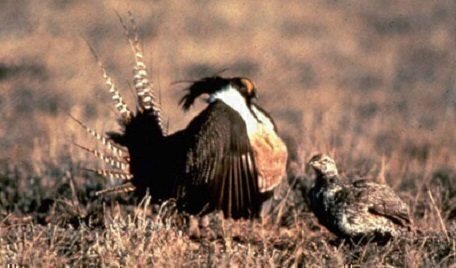A dispute now at the Supreme Court over an alleged Louisiana frog habitat has led to an interesting set of amicus briefs, including one from Utah supporting land owners who feel the Endangered Species Act is too restrictive about protecting a species of grouse.
 In Louisiana, the dispute is over the protection of land that could potentially host the dusky gopher frog, which actually doesn’t live on the property in question. In Utah, San Juan County officials are offering their support based on a similar situation with the Gunnison sage-grouse in their state.
In Louisiana, the dispute is over the protection of land that could potentially host the dusky gopher frog, which actually doesn’t live on the property in question. In Utah, San Juan County officials are offering their support based on a similar situation with the Gunnison sage-grouse in their state.
In July 2017, the Pacific Legal Foundation filed a brief with the Supreme Court asking it to accept an appeal after an administrative decision dedicating protected space for a dusky gopher frog habitat in Louisiana was upheld. In Markle v. U.S. Fish and Wildlife Service, a divided Fifth Circuit Appeals Court refused to hear a full appeal after a smaller panel of judges ruled for the government.
The Fish and Wildlife Service wanted a 1,500-acre tract of privately owned land protected as a potential breeding and living space for the frogs, which currently live in Mississippi and were once believed to live in the tract in question in the 1960s. The tract’s owners want to develop the land.
In its court petition, Pacific Legal Foundation attorney Reed Hopper said the lower court’s decision was an expansion of government powers. “The Fifth Circuit’s decision to authorize the designation of non-habitat as critical habitat is unprecedented in its potential to expand federal authority over local land and water use,” Hopper and his team argued. “It vests federal agencies with virtually limitless power to regulate any and all areas of the Nation based solely on the government’s bald assertion that the regulated areas are ‘essential to the conservation of a protected species.’”
The San Juan County, Utah attorneys hardily agree and are hoping the Supreme Court can provide clarity about their own situation, including an accusation of grouse-grounds gerrymandering.
The County says that only 8 percent of its land is privately owned, as vast parts of the county are federal lands or reservations. But Fish and Wildlife Service officials designated 35 percent of private property as protected habitat, while ignoring any public lands that contain large regions of sagebrush needed by the grouse. The county specifically claims the Fish and Wildlife Service “drew gerrymandered boundaries that excluded its own federal land.”
“There is not even a gambling chance that the Service took a meaningful step toward the recovery of the Gunnison sage-grouse by designating tens of thousands of acres of private agricultural lands and hay farms as critical habitat for the species,” the county claims. “Equally, there is not even a gambling chance that the Service took a meaningful step toward the recovery of the dusky gopher frog by designating 1,500 acres of unoccupied private land in Louisiana as critical habitat.”
San Juan County also claims it is unlikely that its private land, like the tract in Louisiana, is a likely home for the species the Service seeks to protect. “Two years later, the Service designated tens of thousands of acres of private land in San Juan County as unoccupied critical habitat for the Gunnison sage-grouse. The Service did so even though most of the land is entirely uninhabitable by the grouse and has no viable chance to become habitat for the species,” it concludes.
The Supreme Court has extended consideration of petitions in Markle v. U.S. Fish and Wildlife Service until October 13.
Scott Bomboy is editor in chief of the National Constitution Center.







